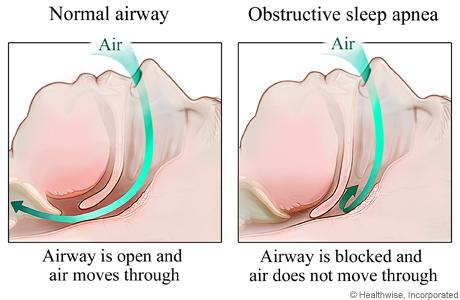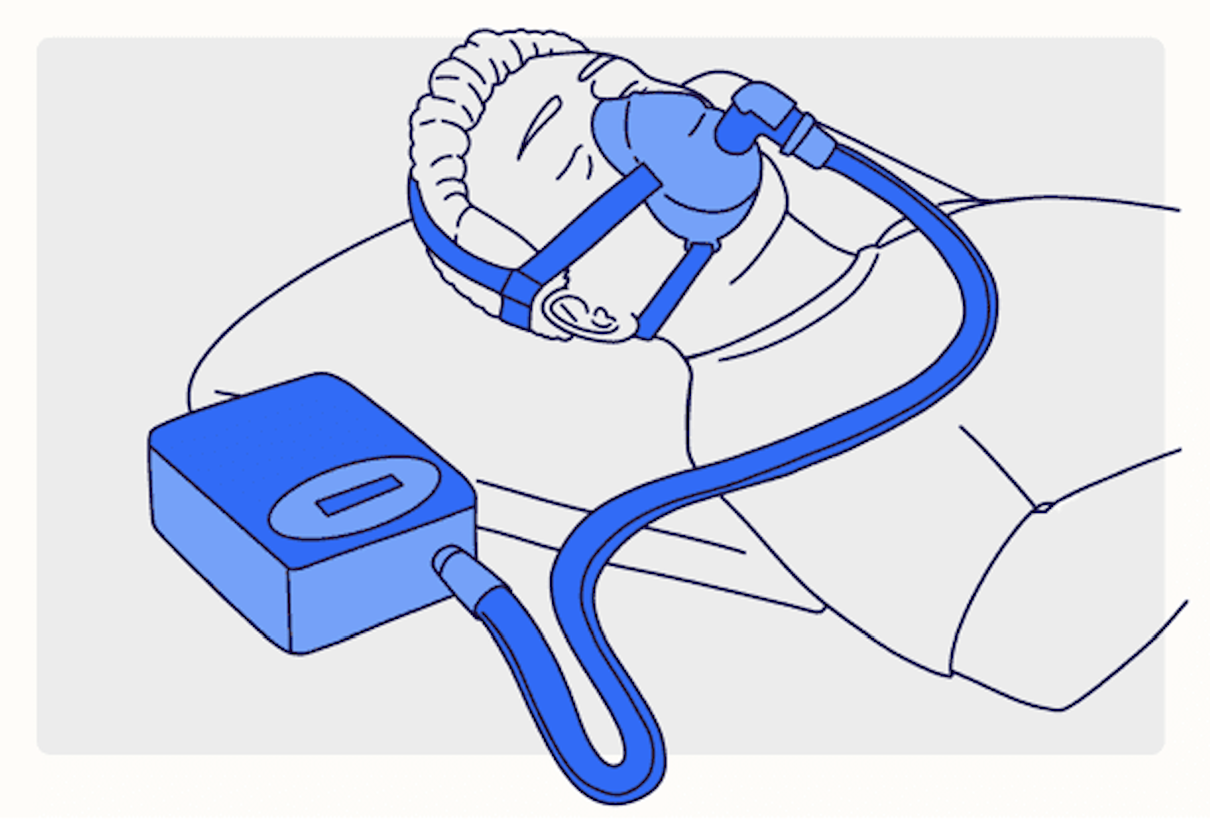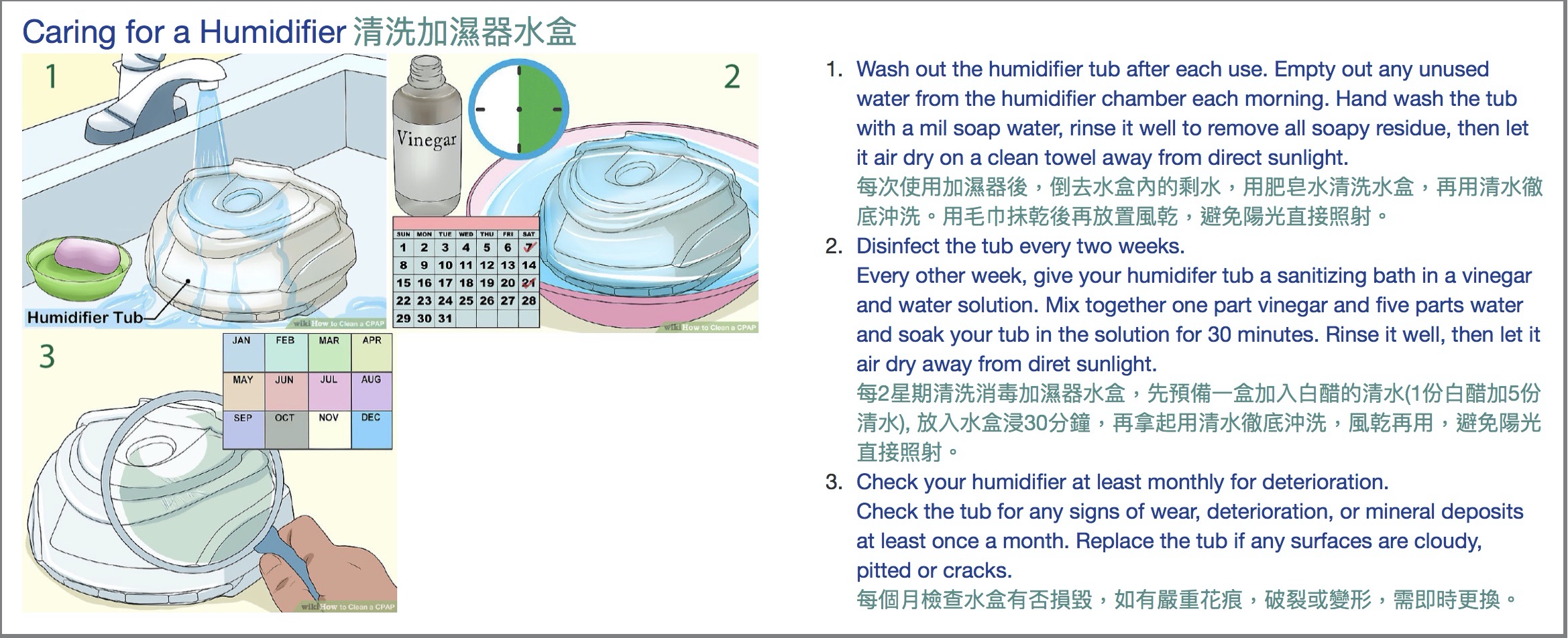甚麼是睡眠窒息症 | What causes sleep apnea
睡眠窒息症有三種:
第一種是氣管被阻塞而無法呼吸,稱阻塞性窒息。
第二種是腦部無法控制呼吸稱為中樞性睡眠窒息症。
最後是混合性睡眠窒息症,即同時有阻塞性及中樞性的睡眠窒息。
There are two main reasons why sleep apnea occurs: airway obstruction or a disconnect between your brain and your body.
Airway obstruction is by far the most common type, causing the symptoms of obstructive sleep apnea (OSA).
A disconnect between your brain and body causes central sleep apnea.
Some people have a combination of both types of sleep apnea. (Mixed or complex sleep apnea).

阻塞性睡眠窒息症 | Obstrucive Sleep Apnea
阻塞性睡眠窒息症是一種常見的睡眠疾病。調查顯示,香港約有4%的中年男士和2% 的中年女士患上此病。
在睡眠時,由於患者上呼吸道的肌肉過度鬆弛,以致阻塞呼吸道,引發短暫呼吸停頓 (窒息)的情況。患者會因為血含氧量下降而驚醒,醒後呼吸回復正常並重新入睡。但 由於短暫窒息的情況會在整晚重複出現數十甚至數百次,以致大大影響睡眠質素,令 患者日間出現渴睡的情況,並影響日常生活及工作。
如患者得不到適當的治療,會加重心肺負荷,增加患上高血壓、心臟病和中風等併發 症的風險。因此,任何人士若懷疑患上睡眠窒息症,應諮詢醫生的意見,決定是否需 要接受檢查或治療。
When you go to sleep, your throat and tongue muscles relax. This can cause the soft tissue in your mouth and throat to fall back and obstruct your airway.
Blocked nasal passages can also contribute to the problem. the obstruction stops you from breathing properly causing your oxygen levels to drop.
After about 10 seconds, your brain detects the low oxygen level and sends a signal to your body to wake up and breathe. At the same time, your blood pressure spikes.
You wake up and take a deep breath, then go back to sleep.
This can be repeated many times a night without you even noticing.

阻塞性睡眠窒息症症狀 | Symptoms for obstructive sleep apnea
- 鼻鼾 | snoring
- 睡眠期間喘氣或呼吸暫停
Gasping for breath or paused breathing during sleep
- 睡眠質素差或失眠 | Restless sleep, insomnia
- 夜尿頻繁 | Frequently urinating at night
- 醒來盜汗 | Waking up with night sweats
- 起床時喉嚨乾燥、疼痛 | Waking up with a dry, sore throat
- 早上頭痛 | Morning headaches
- 白天總是感到疲倦 | Feeling constantly tired during the day
- 記性差難以集中 | Having trouble concentrating and remembering thins
- 性慾減退 | Impotence and reduced sex drive
- 情緒波動 | Mood swings
- 體重增加 | Gaining weight
- 高血壓 | Hight blood pressure
中樞性睡眠窒息症 | Central Sleep Apnea
由於腦部中樞系統無法正常傳遞呼吸訊息,令患者出現窒息。一般出現於患有心臟病、腦部疾病或創傷、中風或先天性疾病等的嬰幼兒或成人,亦可因藥物或高海拔引發。
With central sleep apnea, your airway is not obstructed, but your brain isn’t sending the normal signals to your body to tell it to breathe.
Your breathing stops for 10 seconds or more. During this time your body makes no effort to breathe.
It’s quite likely that you don’t snore with central sleep apnea.
Central sleep apnea may be caused by certain prescription painkillers. It may also be brought on by high altitude or by a medical condition such as cardiovascular disease, stroke, infection or neurological disease.
中樞性睡眠窒息症症狀 | Symptoms for Central Sleep Apnea
- 突然醒來感覺呼吸困難 | Waking up suddenly feeling breathless
- 坐起站立時氣促 | Shortness of breath that is relieved by sitting up
- 失眠,難以入睡 | Insomnia, with difficulty staying asleep
- 白天嗜睡 | Daytime sleepiness
- 夜間胸痛 | Chest pain at night
- 注意力不集中 | Trouble concentrating
- 早上頭痛 | Morning headaches
- 運動困難 | Difficulty exercising
甚麼是連續正氣壓呼吸機 | What is CPAP
連續正氣壓呼吸機(以下簡稱呼吸機)是用於治療中度阻, 塞性睡眠窒息症的常見儀器。 每當睡覺時,患者都必需 使用呼吸機。
呼吸機先把空氣加壓,然後通過面罩把已加壓的空氣輸入患者的上呼吸道,使呼吸道在整個呼吸過程中都能保持暢通。
CPAP, or Continuous Positive Airway Pressure, treats breathing problems such as sleep apnea and chronic snoring, giving people healthier sleep and helping them enjoy better daytime alertness.
CPAP applies mild air pressure to a person's upper airway to keep their airway open so that they can breathe normally while they sleep.

呼吸機的基本配件 | CPAP Components
呼吸機的基本配件包括:鼻罩/全面罩、頭帶、接駁喉管、呼吸機 及濕化器。
- 使用者先用頭帶把鼻罩/全面罩固定在鼻或口鼻部份,然後透過 接駁喉管與呼吸機連接。啟動呼吸機後,氣流便會產生並通過接駁喉管及鼻罩/全面罩 進入上呼吸道,保持氣管暢通。
- 此外,使用者可選擇附加一個濕化器,以減輕乾燥空氣對上呼吸道的刺激。
CPAP equipment includes: Mask, Hose, CPAP machine and humidifier.
- User need to wear the correct mask, connects it with the hose, then connects the other end of hose to the CPAP machine. Turn on the machine, the air will be delivered from the machine to the hose, then to the mask, and finally to your throat when breathing.
- Furthermore, you can use the humidifier to provide the mositure if you feel too dry when breathing.
呼吸機種類 | CPAP Type
呼吸機可分為固定呼吸機及自動呼吸機兩款。
固定呼吸機只會輸出一個固定的氣壓, 而自動呼吸機則會按使用者的需要而自動調節輸出的氣壓。
當使用者出現呼吸道阻塞時,自動呼吸機會自動增加氣壓打通呼吸道;當呼吸道回復 暢通後,呼吸機會自動減低輸出的氣壓。
由於自動呼吸機的使用者無須持續接受高氣壓,所以一般會較使用固定呼吸機為舒適,但它的價錢亦較昂貴。
There are 2 types of CPAP pumps: fixed pressure and automatic pressure.
Fixed pressure pumps apply continuous pressure that has been pre-set to suit your specific requirements.
Automatic pressure pumps monitor airflow and continuously adjust air pressure based on your changing needs throughout the night. These kinds of pumps are most useful for people whose pressure requirements vary during sleep.
評估及診斷睡眠窒息症
Sleep Apnea Self-Evaluation
可透過填寫愛普沃斯嗜睡量表(Epworth Sleepiness Scale),計算在進行特定活動時的打瞌睡情況,評估患者嗜睡的程度:
Check below Epworth Sleepiness Scale to evaluate your status about sleep apnea.
(從不發生: 0分; 很少機會發生: 1分; 間中發生: 2分; 經常發生: 3分)
(Would never nod off: 0; Slight chance of nodding off: 1; Moderate chance of nodding off: 2; High chance of nodding off: 3)
-
- 進行的活動 | Activites
- 評分 | Status
- 1
- 坐著閱讀 | Sitting and reading
-
- 3
- 在公眾場所坐下 | Sitting, inactive, in a public place
-
- 4
- 乘坐交通工具多於一小時 | As a passenger in a car for an hour or more
-
- 5
- 中午躺下休息 | Lying down to rest
-
- 6
- 坐著和別人交談 | Sitting and talking to someone
-
- 7
- 午餐後在沒有飲酒的情況下坐著休息 | Sitting quietly after a meal without alcohol
-
- 8
- 乘車或駕車時短時間停車等候 | In a car, while stopped for a few minutes in traffic or at a light
-
將測試結果相加得出總數,可得知患者嗜睡程度:
Add up your points to get your total score and check the status below:
0 - 9 : 嗜睡情況正常 | Normal
9 + : 很大機會患有睡眠窒息症 | It is very likely that you have sleep apnea.
其次可進行多頻道睡眠檢查(Polysomnography),透過感應器連接身體相關部位,對患者進行睡眠監控,收集患者睡眠冒的物理及生理的數據以作分析及診斷。
For more accurate to check the sleep apnea, please check with your doctor for the Polysomnography (PSG) test:
一般多頻道睡眠檢查包括 | PSG includeds:
- 監測腦電波 | Electroencephalography (EEG)
- 監測心臟活動 | Electrocardiography (EKG or ECG)
- 監測眼球活動 | Electro-oculography (EOG)
- 監測肌肉活動 | Electromyogram (EMG)
- 監測血含氧量 | Pulse oximeter
- 量度口腔及鼻腔的氣流 | Breathing sensors
- 量度胸部及腹部活動 | Respiratory inductive plethysmography (RIP) belt
- 量度鼻鼾的聲浪 | Video and audio monitoring

選購及使用呼吸機須知:
- 睡眠窒息症患者必須經醫生評估並擬定治療方案,才可使用呼吸機。
Before using CPAP respirator, sleep apnea patients should consult their doctors for assessment and prescription of the treatment plan.
- 選購前,使用者應考慮的因素包括:呼吸機的寧靜程度、機身的大小及重量、是否適 用於國際電壓和外遊、睡床旁邊是否有足夠空間擺放儀器等。
Before choosing a respirator, one has to consider factors such as: the noise that may be generated, the size and weight of the respirator, international voltage compatibility and suitability for travelling and adequacy of space for placing the respirator beside the bed.
- 除考慮呼吸機的售價外,還須注意其他配件如鼻罩/全面罩及接駁喉管的價錢及更換頻率。
Apart from the price of the respirator, one should also consider the frequency of replacing the accessories and their prices.
- 應向代理商查詢售後服務的詳情,如保養範圍、維修期間是否有租機服務及更換零件 的收費等。
Obtain information from the suppliers regarding maintenance details such as the scope of maintenance, availability of rental service during repair, and the price of replacement of components, etc.
- 有部份供應商會提供試機服務,使用者可先租用呼吸機,視乎是否適合才決定購買。
Some suppliers offer home trial service. Users may rent a respirator and try it out before deciding to purchase.
- 選擇貼面舒適的鼻罩/全面罩。
Choose fit and comfortable nasal mask/face mask.
- 使用呼吸機前,應諮詢和跟從醫生的專業意見,並遵照製造商產品說明書的指引正確 使用呼吸機,並聯絡供應商作定期保養。
Seek and follow doctor’s professional advice regarding the use of CPAP respirator. Follow the manufacturer’s instructions in the operation manual to ensure the device is properly operated. Contact the supplier for regular maintenance.
- 使用者必須定期覆診。如有不適,應諮詢醫生意見。
Users should attend regular check up and seek medical advice if discomfort is experienced.
呼吸機配件的護理 | Maintenance and Care
護理及清潔不同牌子配件的步驟都有分別,應參照製造商的產品說明書。
The procedures for maintenance and care of accessories from different brands may vary. It is advisable to refer to manufacturer’s instruction.
- 呼吸機配件
Accessories
- 護理時間
Frequency
- 護理方法
Ways to care
- 鼻罩/全面罩
Mask
- 每天
Daily
- 用已稀釋的清潔液及清水清洗。
Clean with diluted detergent and water.
- 然後在陰涼地方掛起風乾。
Hang to dry but avoid exposure to sunlight.
- 待乾透後才使用。
Ensure it is dry before use.
- 濕化器
Humidifier
- 每天
Daily
- 為減低感染退伍軍人病的機會,濕化器只可使用無菌水,(不 要使用蒸餾水或來自水龍頭的食水)。無菌水在本港大部分的 藥房均有出售。
To reduce the risk of contracting Legionnaires’ disease, use only sterile water to fill up the humidifier (Do NOT use distilled water or tap water). Sterile water is available from most dispensaries.
- 每日要替換貯水瓶內的無菌水。
Never leave stagnant water in the humidifier.
- 切勿讓濕化器的貯水瓶儲存積水。傾倒後,抹乾貯水瓶的所有表面,並且注入新的無菌水。
Empty the water tank, keep all surface dry and change the sterile water daily.
- 濕化器
Humidifier
- 定期
Regularly
- 應按照製造商的指示定期清潔及保養。清潔或消毒後,應用 無菌水或煮沸後剛冷卻的食水沖洗。
Clean and maintain the humidifier according to manufacturer's instructions. After cleaning or disinfection, rinse the humidifier with sterile water or cooled freshly boiled water.
- 如需更多有關退伍軍人病的資訊,請參閱衞生防護中心網頁。
For more information on Legionnaries’ disease, please visit the webpage of the Centre for Health Protection
- 呼吸機
Respirator
- 定期
Regularly
- 先拔掉電源,用沾上溫和清潔液的布清潔呼吸機的外殼。
Unplug the system and clean with a cloth moistened with mild detergent and water.
- 待機身完全乾透後,才可接駁電源。
Let the respirator dry completely before plugging in the power cord.
- 隔塵網
Dustfilter
- 每月
Regularly
-
遵照製造商的指示定期清潔或更換。
Clean or replace the dust filter according to manufacturer's instruction.






